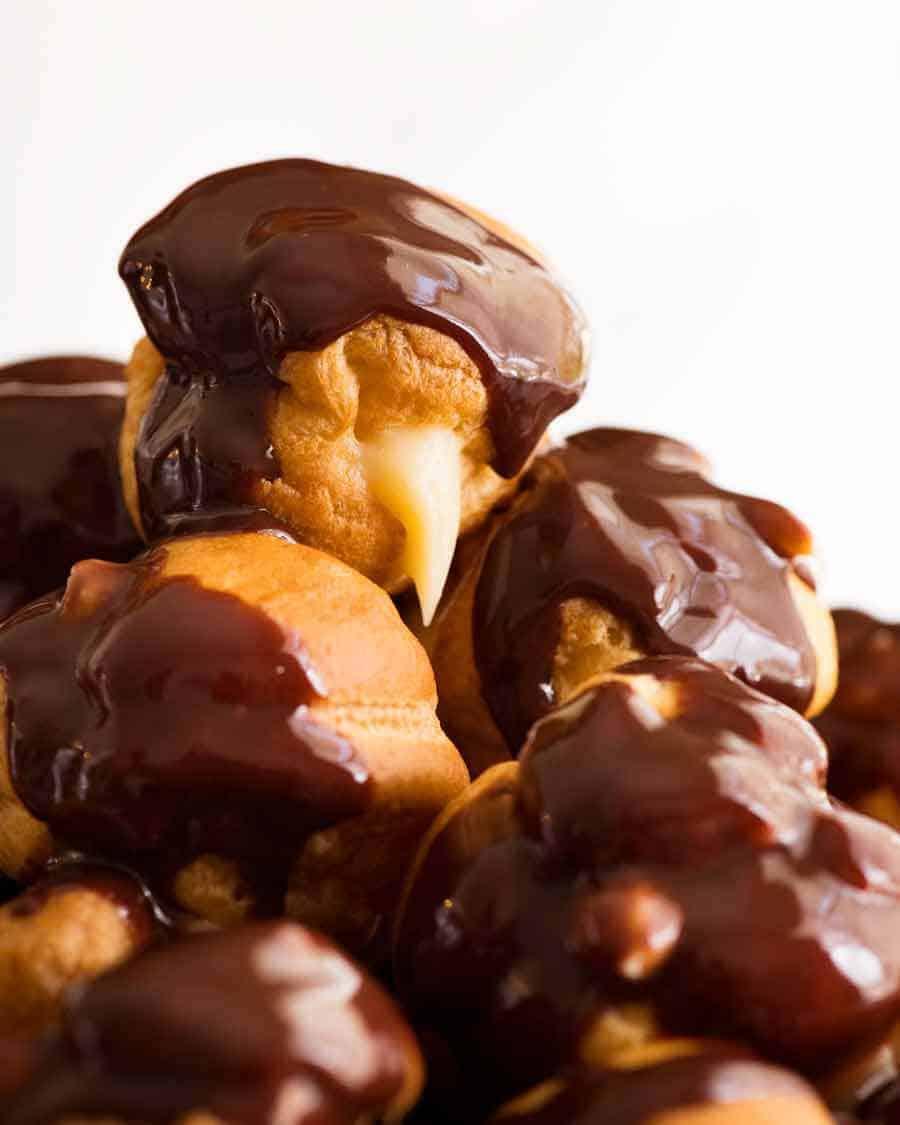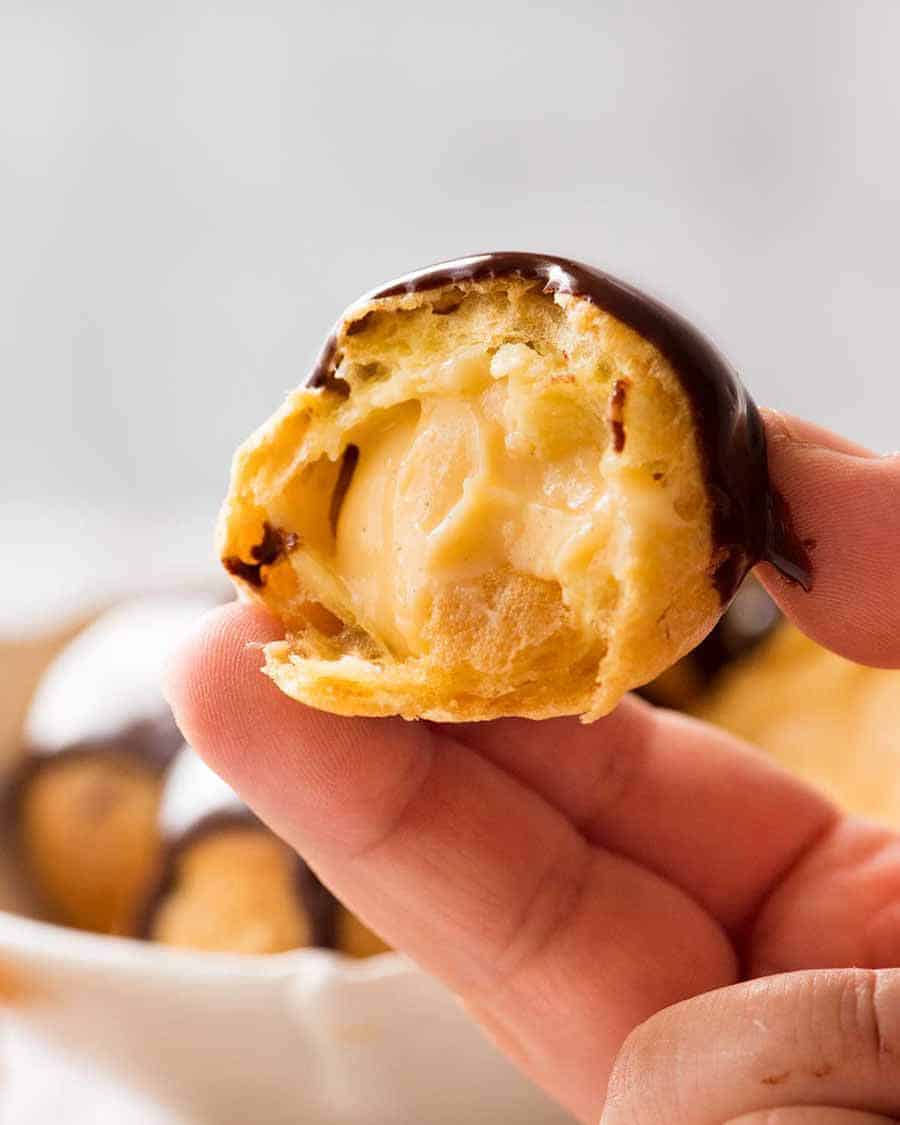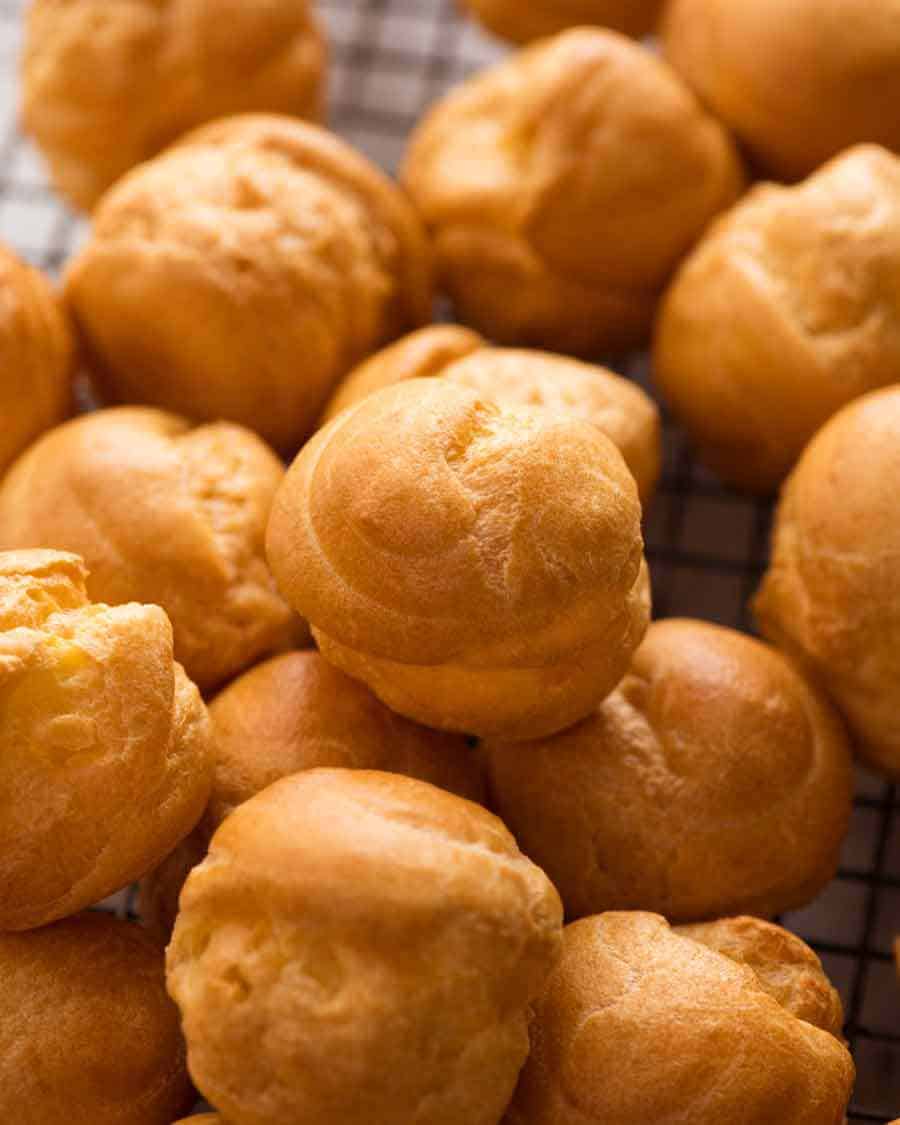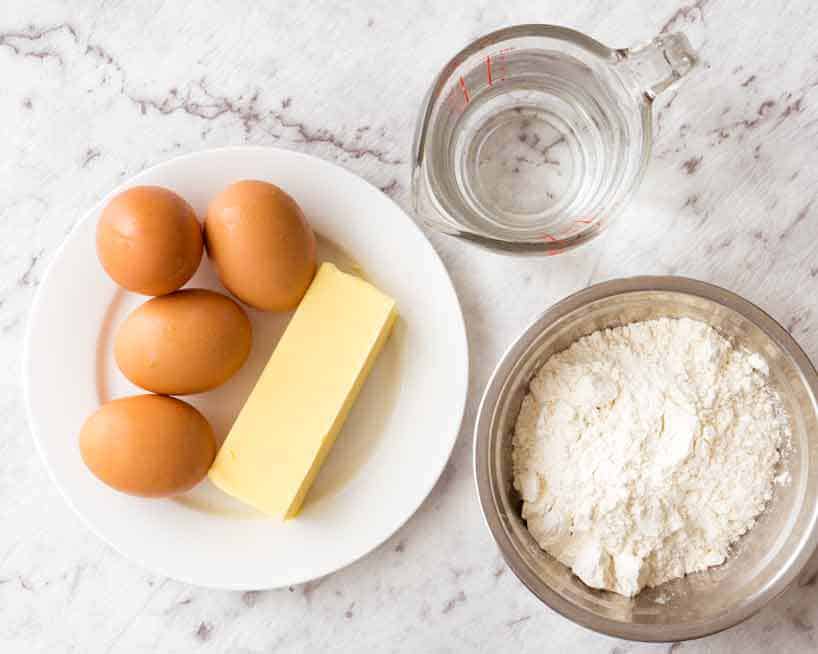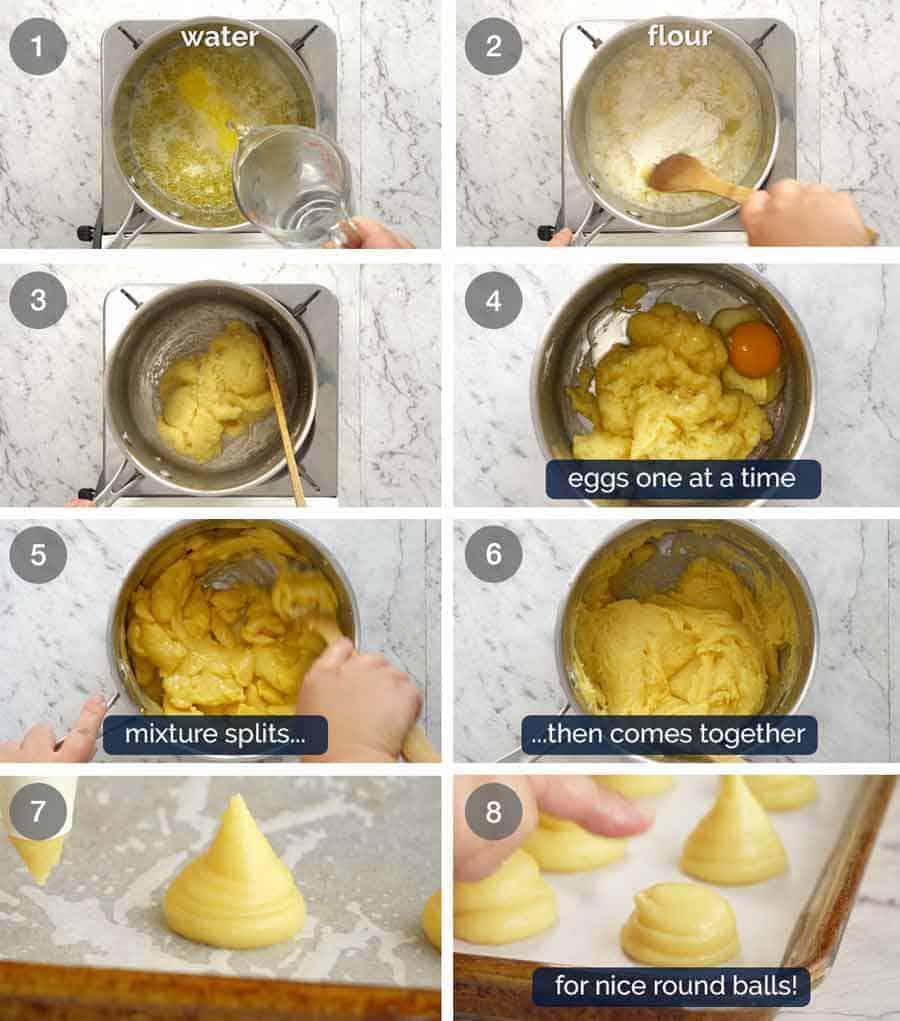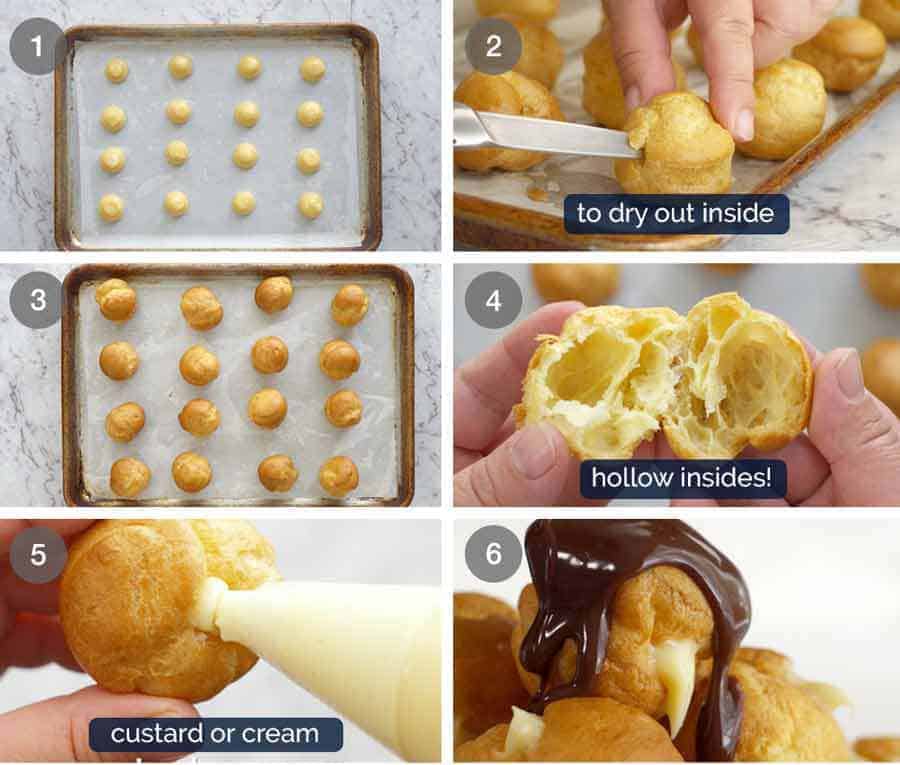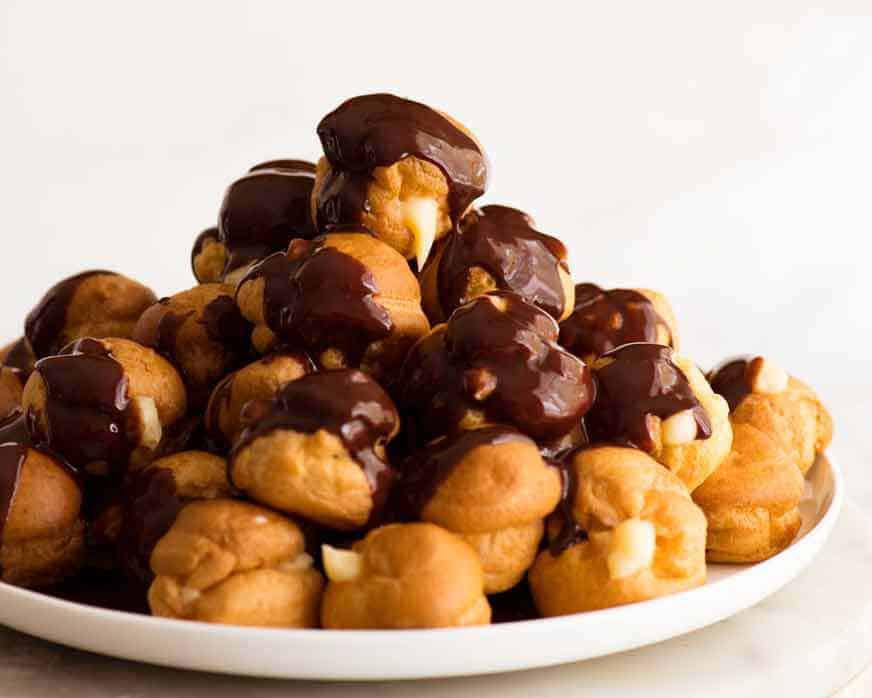The pastry shells can be made days, even months in advance. And one batch makes almost 50 profiteroles!!
Profiteroles
Profiteroles are a hazard. It is way too easy to inhale an indecent amount in one sitting. I exaggerate not. Because unlike many desserts, profiteroles seem so light rather than heavy and overly sweet. Combine that with the fact that they are so small, you can easily swipe one without anyone noticing as you casually stroll past the pile (yet again…), and you don’t even need to break stride as you bite into it. Or better yet, if you can manage the whole thing in one bite… For the record, I cannot. I am a Two-Bite-Profiterole gal.
PROFITEROLE PASTRY = CHOUX PASTRY
Those crispy, light as air profiterole balls are called choux pastry balls. It’s French and it’s magical. 4 simple ingredients: butter, water, egg and flour. Mix, pipe (or even dollop), bake. And whoosh! Those little innocent looking blobs of pastry puff up 5 or 6 times and they’re hollow inside, just begging to be filled with something tasty!
3 parts to profiteroles
Profiteroles are made up of 3 components:
- The pastry balls (choux pastry) – crispy on the outside, hollow on the inside, ready to be filled with your Filling of choice!
- Filling – there’s a few options here. Vanilla custard (Creme Patissiere) is the most common here in Australia – piped inside the balls. Cream is also a firm favourite – and also a good quicker filling option to making homemade custard. And then there’s profiteroles in the States which are split then stuffed with ice cream rather than piping a filling in. All are delish, but for me, profiteroles filled with custard will always be my favourite child. 😂
- Chocolate Sauce – Drizzle or dip the profiteroles in the chocolate sauce. When it’s warm, it’s a chocolate sauce. When it cools, it sets to a soft chocolate – like the chocolate you get on eclairs at bakeries.
What goes in Choux pastry – profiterole pastry balls
Here’s all you need to make Choux pastry – eggs, butter, water and flour. There’s no baking powder or other rising agent. The thing that makes choux pastry puff up is the large volume of water in the batter which evaporates into steam as it bakes, causing the protein in the egg to expand and puff up
How to make choux pastry – profiterole pastry
Choux pastry is really easy to make, it’s just a little different to the usual cake batters so there’s a couple of things to be aware of:
After mixing the water, butter and flour, remove from the stove to cool for 10 minutes before adding the egg, otherwise the heat will cook the egg and prevent the choux pastry from rising; and Add the egg one at a time and mix well in between. The dough will split initially, but after a bit of vigorous mixing, it will come together.
Though I’ve used a piping bag for the dough, you can even just use 2 teaspoons to drop little dollops of the dough onto baking trays!
How to bake choux pastry for profiteroles
A key step in making profiteroles is the double bake of the pastry balls. The pastry balls cook through and puff up in the first bake. Then the balls are pierced and returned to the oven for a second bake to dry out the inside. The reason this is an important step is to prolong the life of the profiteroles once filled with custard or cream. And it’s during the second bake that the balls become fabulously crispy!! Cool, then pipe in custard or cream, drizzle with chocolate and they’re ready for serving.
Tips to ensure profiterole success
Profiteroles might look tricky and fancy, but they are actually very straightforward to make if you follow just 3 key tips:
- Cool dough before adding eggs – this is key to ensure the heat from the dough doesn’t cook the eggs and so they incorporate properly when mixed together. The egg is the key to making the Choux pastry rise and become hollow;
- Mix eggs in thoroughly – the dough will look like it splits when you start mixing the eggs in, but persist! The batter will come together – it needs to be smooth;
- Don’t pierce until crispy – A key step is to remove the profiteroles partway through baking to pierce a hole in them, then return into the oven. This is to make them dry out and cook inside so they hold their shape (and so it’s not raw batter inside). But you must ensure you DO NOT pierce them before the outside is crispy, otherwise the ball will collapse when you return it to the oven. The shell should take 15 minutes in a 180°C/350°F oven to become crispy, but if your oven runs a bit weak (or not preheated long enough or you kept door open too long and let heat escape etc etc) then you may need to keep them in for slightly longer. Watch the recipe video at 57 seconds and you will see that when I puncture a hole in the ball, the surface cracks around the hole, indicating that the shell is crisp. TOP TIP to ensure success: read the recipe from start to finish, look at the step photos above and watch the short recipe video!
Profiterole troubleshooting
The most common problem that people run into with profiteroles is that they don’t rise, don’t rise enough, are soggy or they collapse – either during the 2nd bake (after puncturing a hole) or after taking them out of the oven. All these can occur due to the same factors (all of which can be avoided if you follow my recipe as written!!):
Batter is too runny – when you pipe blobs, if it spreads out rather than sitting up (as shown in the step photos above and video below), this means the batter is too runny and therefore the profiterole balls will not rise. The batter can only be too runny if you mis-measured the ingredients. In particular, ensure you are using the correct size eggs; The eggs were not incorporated properly – when you add the eggs, mix mix mix until the batter is smooth again. If the batter is split, it means the eggs are not mixed in properly = balls won’t rise (because it is the eggs that make profiteroles rise) Pierced balls before they were crispy – if you pierce the balls before they are crispy and can hold their shape, then they will collapse during the second bake; Forgot to pierce!! If you do not pierce the balls, then the inside will never cook / dry out. Soggy insides = collapsed profiteroles.
MAKE AHEAD –> TAKE TO GATHERINGS
All the components can be prepared ahead separately then assembled closer to serving. The pastry balls can even be made months in advance and stored in the freezer. Just a few minutes in a cranked up oven is all that’s required to make the shells crispy again!!! Imagine being the person who brings a pile of profiteroles like this to a gathering…. The praise! The flattery! You will steal the show!! 😂 Truthfully though, I took profiteroles on a weekend away with friends recently. And what I described above ↑↑↑ is exactly how I did it. I took a giant container filled with the balls, a piping bag filled with the custard and the chocolate sauce in a tub. Then I crisped the shells in the oven very briefly. Piped in the custard, warmed the chocolate, drizzled it over then served. I swear I wasn’t trying to steal the show. I swear I wasn’t trying to show off. I just wanted to share these with my friends! 😂 ~ Nagi x
WATCH HOW TO MAKE IT
Sometimes it helps to have a visual, so watch me make these Profiteroles! {Note: Separate video for custard will be published tomorrow}
LIFE OF DOZER
His giant paws fit perfectly in my size 6 thongs……
